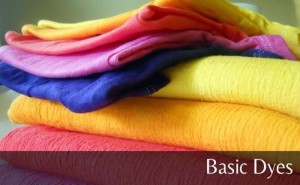
Fabrics are attractively colored to heighten their appeal and sales. Color is added to the fabric base in two ways; dyeing and printing. Dyeing engulfs the entire fabric in colour while printing lends color in specific places. The main ingredient in the dyeing process is the dye which comes in two classes namely natural dyes and synthetic dyes. Dyes obtained from natural sources like nuts, flowers, berries etc. are called natural dyes while those based on chemical compositions are termed as synthetic dyes. You have a wide variety here like acid dyes, basic dyes, sulfur dyes, reactive dyes and many more.
When you talk of color in a fabric, three terms are used to describe and identify color and they are hue, value and chroma. Hue refers to the color name like pink, scarlet, beige and so on while value refers to the hue shade or tone such as its darkness or lightness. A color is said to have light value if it is closer to white whereas it has a dark value if it is closer to the deeper color. Chroma refers to the color depth that is its brightness, vividness, intensity or purity. A bright, vivid color is supposed to possess high chroma.
Two types of color mixing takes place in the world of textile dyeing. It is additive color mixing or subtractive color mixing. The latter type is involved in the mixing of printing pastes and dyes. Dyes and pigments are the two colorants that form an important component of the textile industry. Pigments also come in a wide array to suit the varied requirements of the industry. For a dye to be used in the textile industry it has to possess attributes of water solubility, affinity to the textile substrate, intense color and sufficient fastness.
Classification of dyes is done based on two factors namely its chemical constitution and secondly its method of application. There are innumerable chemical classes reported today and a single dye can belong to multiple chemical classes. So you have the Azines, Anthraquinones, Xanthenes, Aminoquinones and so on. When you go on the second basis that is the method of application the classification forms a tree branching into several segments. Synthetic, natural and ingrain dyes form the three groups with synthetic further sub divided into water soluble and water insoluble categories.
Water soluble dyes include direct, acid, reactive, basic dyes and optical whiteners while vat, sulphur and disperse dyes come under water insoluble dye category. Each of the dye is allotted a unique name depending upon their hue, value and chroma. Direct black 22 for example is one such name given to a specific shade of a direct dye.
Any shade that may be needed for your application has to be sourced from a reputed dealer or manufacturer. Reputed producers have sophisticated technology, quality control measures and expert personnel in place and hence the product that comes from their production unit will be nothing less than top quality. If you want to ensure a long lasting coloring effect to your application then always go to reputed sellers for fulfilling all your requirements.